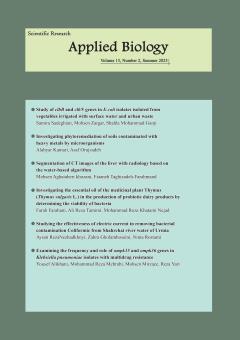Subject Areas : microbiology
aysan rezanezhad
1
![]() ,
Zahra Gholamhoseini
2
,
nima rostami
3
*
,
Zahra Gholamhoseini
2
,
nima rostami
3
*
![]()
1 - Islamic Azad Univercity
2 - Master's Degree, Department of Microbiology, Department of Biology, Faculty of Basic Sciences, Urmia Branch, Islamic Azad University, Urmia, Iran.
3 - Ph.D., Department of Microbiology, Marand Branch, Islamic Azad University, Marand, Iran
Keywords: Disinfection, Coliform bacteria, Electricity flow, Shahrchai River, Urmia.,
Abstract :
Purpose: Water disinfection is one of the most important stages of water purification in terms of ensuring the health of consumers. Although common methods in drinking water purification can effectively control microbial factors, the formation of disinfection byproducts has made the process of using these methods a challenge. On the other hand, physical and chemical disinfectants are often limited due to their low efficiency, high price and production of toxic products. In the meantime, one of the methods that has been in the spotlight and developed a lot in recent years is the use of electricity to remove biological pollutants from water. Therefore, the aim of the current research is to study and evaluate the efficiency and effectiveness of the method of establishing the current of electricity in removing the coliform bacteria population in the Shahrchai River of Urmia. Materials and methods: The present research, which is descriptive-cross-sectional, started in a period of six months from February 2018 and continued until July 2019. The water sampling process of Shahrchai River in Urmia was carried out from two stations at the entrance of the No. 1 treatment plant and at the entrance of the Golshahr treatment plant, and the samples were transferred to the laboratory within 2 to 4 hours, and the presence of coliform bacteria was studied and measured by the MPN method. Then, in order to perform the electrolysis test, an electrochemical reactor with a voltage of 220 volts consisting of two electrodes made of iron and aluminum was prepared and the electric current was established for 10, 20, 30 and 70 minutes. Next, the data results were analyzed by SPSS version 21 software. Findings: The results show that the efficiency of coliform bacteria population removal depends on the pollutant source, duration, current intensity and type of electrodes. According to the results, the slope of the curve of changes in the amount of microbial contamination of the samples that were subjected to a constant current of 220 volts for 20 minutes showed a significant decrease. So that the microbial load of most samples was reduced by 50%. Therefore, it can be said that the removal efficiency has a direct relationship with the increase in time, and with the increase in the duration of the electric current in the samples, the removal rate of coliform bacteria also increases significantly. Conclusion: According to the results of this research, the use of the process of establishing the current of electricity is suggested as a suitable method with high efficiency and also compatible with the environment in water disinfection.
1. Poorsaadat L, Jamshidfard AR & Davami, MH. effect of direct electericity curent on water infected with jiardia lablia. Journal of medical research. 2004; 3(1): 65-70. [in persian]
2. Behnam B. Virginia household water quality program: Bacteria and other microorganisms in household water. Virginia Cooperative Extension; 2011: 442-662. [in persian]
3. Ganesh S. A novel yogurt product with Lactobacillus acidophilus. M.Sc. thesis. Louisiana USA; 2006: 50.
4. Gholami M, Nazari SH, Yari AR & Mohseni S. Removal of E. coli and S. aureus from polluted water using electrolysis method with Al-Fe electrodes Tehran University Medical Journal. 2017; 2: 85-95. [in persian]
5. Gholami M, Nazari S, Farzadkia M, Majidi G & Alizadeh Matboo S. Assessment of nanopolyamidoamine-G7 dendrimer antibacterial effect in aqueous solution. Tehran Univ Med J. 2016; 74(3): 159-67. [in persian]
6. Gholampour Azizi I, Hashemi Karouei SM, Esmaeilpour ME & Mohseni R. Disinfection of water contaminated with Vibrio cholerea by electrical current. World Appl. Sciences. 2011; 13(6): 1455-1458. [in persian]
7. Gholami M, Nazari S, Farzadkia M, Mohseni SM, Alizadeh Matboo S, Akbari Dourbash F & et al. Nano polyamidoamine-G7 dendrimer synthesis and assessment the antibacterial effect in vitro. Tehran Univ Med J. 2016; 74(1): 25-35. [in persian]
8. Gheizanzade S & Mafi Gholami R. Removebel of petroleum hydrocarbons from oil effluent by electro-coagulation method. Pajuhan scientific Journal. 2017; 15(2): 5-12. [in persian]
9. Iranian institution for standards and economic research. Physical and Chemical Properties of Drinking Water. Standard Number 1053, 1997, 5th.
10. Iranian institution for standards and economic research. Microbial Properties of Drinking Water. Standard Number 1101,1997, 4th.
11. Kasra Kermanshahi R & Sailani MR. Gram negative bacteria are more sensitive to electric field than gram positive bacteria. In: 4th National Biotechnology Congress of Iran, Kerman, 2005. [in persian]
12. Zhu Z, Deng Q, Zhou H, Ouyang T, Kuang Y, Huang N & Qiao Y (2002). Water pollution and degradation in pearl river Delta, south china. Ambio, 31(3): 226-30.
13. Petrofsky J, Layman M & Chung W. Effect of electrical stimulation on bacterial growth. Med. Sci. Monit. 2005; 20: 1-21.
14. Tanhaei V & Rostami Koshki N. Water Qualitative monitoring of water of Mahabad River in terms of microbiological parameters Based on Protocol 1011 of the National Iranian Standards Organization. NCMBJ. 2018; 8(31): 57-64. [in persian]
15. WHO. Progress on sanitation and drinking-water-2014.
16. Hoseini SA, Amiri Kojuri S & Hashemi SM. effects of electerical current on fungal and bacterial removal from water. Water and wastewater J. 2016; 27(103): 20-25.

